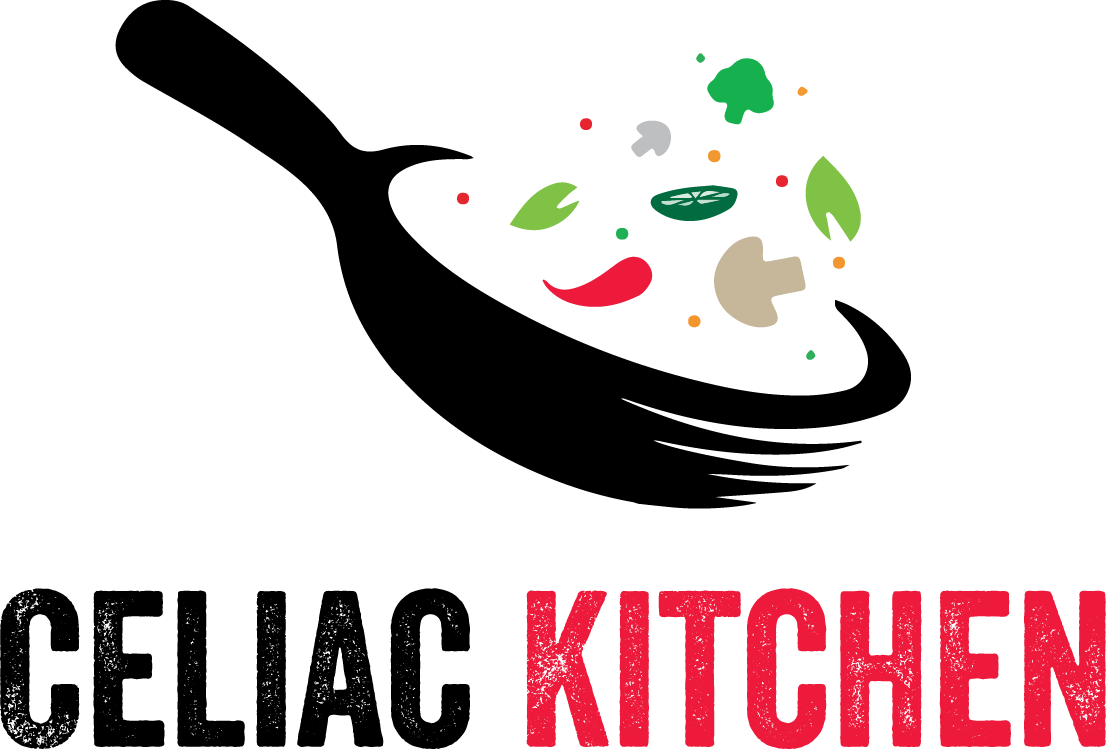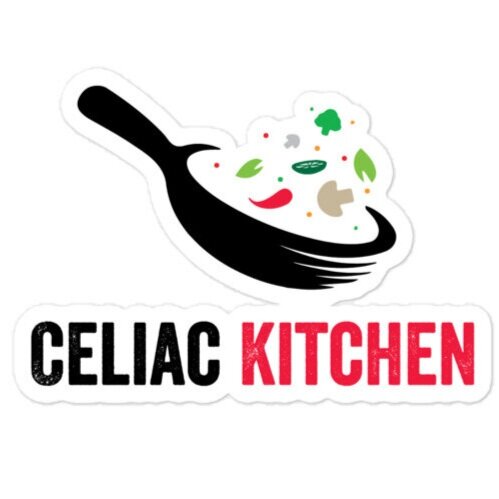Gluten Free Pie Crust Recipe
Are you looking for the perfect gluten free pie crust, one that compliments your favorite filling and looks gorgeous with a flaky texture and the right amount of golden brown color? Look no further, we have just the recipe for you. Just add your favorite gluten free filling and enjoy!
A video demonstration of this recipe is on Celiac Kitchen’s YouTube channel
Gluten Free Pie Crust
Ingredients for 1 full size pie crust or 2 mini 5" crusts:
¼ cup (60 ml) water
1 tablespoon (15 ml) apple cider vinegar
330 g (just under 2½ cups) gluten free all-purpose baking flour (we used Bob’s Red Mill Gluten Free All-Purpose Baking Flour)
1 teaspoon xanthan gum
1 tablespoon sugar + about a teaspoon to sprinkle on top of egg wash prior to baking
1½ teaspoons salt
165 g (1 stick + 3.6 tablespoons) frozen unsalted butter
2 eggs (1 egg in dough; 1 for egg wash just prior to baking)
1 tablespoon milk
Directions:
In small bowl add:
¼ cup (60 ml) water
1 tablespoon (15 ml) apple cider vinegar
Swirl together then pop it in the freezer to get it as chilled as possible, but not frozen
In a large mixing bowl combine dry ingredients:
330 g (about 2½ cups) flour*
1 teaspoon xanthan gum
1 tablespoon sugar (helps get good browning)
1½ teaspoons salt
Give ingredients a quick mix on low speed; set aside
Shredded Frozen Butter
This extra step is worth it as it helps with getting a beautiful flaky crust. If it’s not possible, cut really cold butter into very small cubes
Add butter:
Shred 165 g (1 stick + 3.6 tablespoons) frozen unsalted butter**
Form a well in the middle of dry mixture and add shredded butter to the well
Give the butter and dry ingredients a little bit of mixing on low speed (about 2 minutes) until you see small coarse bits like sand as well as some larger chunks; this will give us a nice, varied texture to the dough
Pull chilled water and vinegar mix from freezer:
Add 1 egg into the liquids and mix well
Form a well in center of mixing bowl:
Pour in very cold water, vinegar, egg mixture
Mix on low speed for about 1 - 2 minutes until ingredients are incorporated
We want to mix this as little as possible; stop mixer about half way through to scrape sides and stir it together by hand for a bit
Mix dough until ingredients are incorporated
You will see butter marbled throughout the dough… butter that will add flakiness. Dough should remain chilled at all times before going into the oven
Let dough rest in refrigerator:
Spread a thin layer of corn starch in the center of a piece of cling film large enough to cover dough ball***
Wrap dough in cling film so it’s airtight
Refrigerator for a minimum of 1 hour to hydrate and chill; it can sit in refrigerator overnight
Roll out Dough:
When making two mini pies, cut the dough in half before rolling it out
Heavily corn starch your work surface to prevent sticking and dust the dough ball with cornstarch
Roll dough into a large rectangle
A Designated Kitchen Ruler
Slide your ruler underneath the dough to lift it off your work surface and begin folding the dough in thirds
Fold dough:
Place a kitchen ruler**** at top edge of rectangle; slide it under dough to lift top 1/3 of rectangle
Fold top 1/3 of dough onto rectangle
Repeat this step with bottom third of rectangle
Fold over 1/3 from left side and repeat with right side
Rotate dough so folded end is facing you
Set aside dough to re-cover workspace with a good layer of corn starch
Place folded dough back on center of workspace
Roll out according to the size that will fit your pie pan plus about 2” extra - about 1” for depth and another 1” overhang for a beautiful border
Roll until about 1/8” thick
Remove excess dough
An easy way to transfer dough to pie pan is to roll it onto rolling pin and place it over pan
Press dough into pan
Shape edge into your favorite pattern
Using scraps of dough and exacto knife to make decorations
Refrigerate for at least ½ hour so its shape sets
Coat bottom crust to prevent getting a soggy bottom crust such as corn syrup, egg white, chocolate - something that is compatible with flavor of the filling
Fill crust with a favorite filling
Trim away excess dough; use it for decorations
Place rolling pin underneath dough and use it to help lift dough up and place it in your pie pan
Shape dough in pan
Seal bottom crust so it does not get soggy
Egg wash:
1 egg
1 tablespoon milk
Mix well
Gently brush egg wash onto crust as well as under any decorations that need to be held in place
Sprinkle a light layer of granulated sugar over everything that has egg wash on it
Bake at 350°F
Check ½ way through to be sure crust is not burning; if crust is baking faster than pie filling, place an aluminum foil tent over edges to prevent further browning
Bake 45 – 60 minutes or until filling is puffed around the edges and set; a slight jiggle indicated they need more time
Final Steps
Fill crust, brush with egg wash, sprinkle with granulated sugar and your pie is ready to go into the oven
Helpful Hints:
* 1. Measuring dry ingredients using a scale; weight-based measuring is more accurate
2. Place large mixing bowl on scale; tare the scale to take away the weight of the bowl
3. Bob’s Red Mill Gluten Free All-Purpose Baking Flour is one brand of GF flour that has a good protein content for pie crust
** 1. Shredded frozen butter brings flakiness and a nice rice to pie crust
2. As an alternative to shredding, get butter as cold as possible and cut it into small cubes
3. Rotate stick of butter while shredding it to keep it from getting too soft from the heat of your hand
*** 1. Corn starch prevents dough from sticking to surfaces
2. Keep edges free of corn starch so cling film can create a seal to keep in moisture
3. Form dough into a ball rather quickly so heat from your hands doesn’t warm the dough
4. Keeping the dough chilled is key to getting a light flaky crust
**** A ruler that’s used exclusively in the kitchen and washed between uses is a great tool to have on hand when making pastry
FAQs
Q: If I use salted butter should i not add the regular salt?
A: For a single recipe, omitting the salt is optional. As you double or triple a recipe, it can make more of a difference since different brands of salted butter vary in the amount of salt that's been added. I've seen ranges from 1/4 tsp to 3/4 tsp per stick (Kerry brand is one of the highest ratios, whereas the Land-O-Lakes brand contains 1/4 tsp per stick). If you know how much salt the brand of butter you're using has, you can subtract that from the amount of salt you add to the recipe. If you are unsure, I suggest going with your preference of "saltiness" and remove in the range of 1/4 to 1/2 tsp of salt per stick of butter.
Q: I love the hint about brushing corn syrup on the bottom of the crust but is there a reason why you don't dock the bottom too? I always did that with glutened pie crust, but maybe that's what the corn syrup is for?
A: For me docking is to help get an even bake and allow steam to release when blind baking (aka pre-baking the crust before adding filling) and just as a personal preference, I very rarely blind bake. I've found using the sealing technique to be sufficient in getting a strong, even, not soggy bottom.
Q: For two crusts should i just double recipe? Thank you
A: For making 2 crusts, doubling the recipe should work fine. I recommend dividing the dough and rolling it out per crust instead of trying to roll all that out at once.










